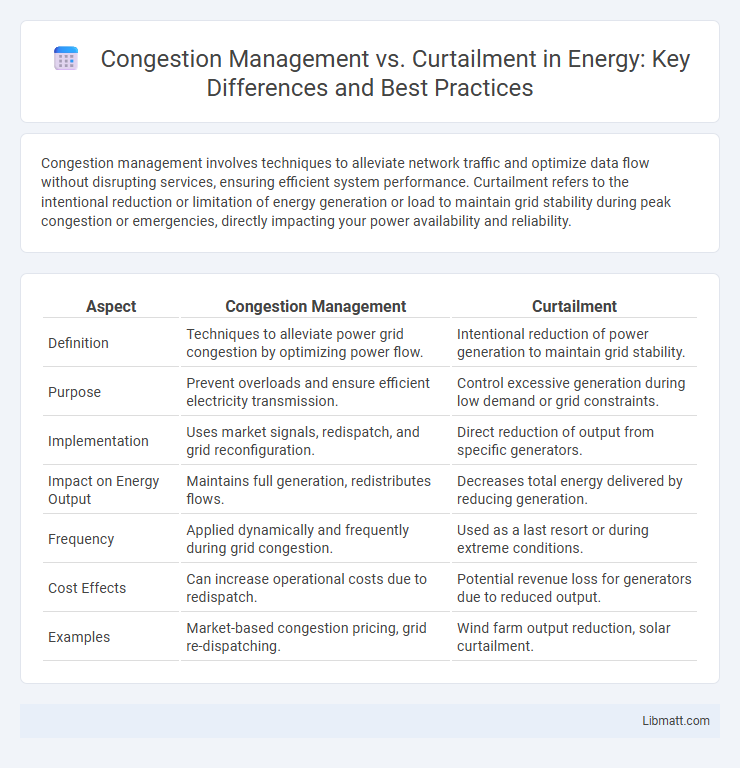Congestion management involves techniques to alleviate network traffic and optimize data flow without disrupting services, ensuring efficient system performance. Curtailment refers to the intentional reduction or limitation of energy generation or load to maintain grid stability during peak congestion or emergencies, directly impacting your power availability and reliability.
Table of Comparison
| Aspect | Congestion Management | Curtailment |
|---|---|---|
| Definition | Techniques to alleviate power grid congestion by optimizing power flow. | Intentional reduction of power generation to maintain grid stability. |
| Purpose | Prevent overloads and ensure efficient electricity transmission. | Control excessive generation during low demand or grid constraints. |
| Implementation | Uses market signals, redispatch, and grid reconfiguration. | Direct reduction of output from specific generators. |
| Impact on Energy Output | Maintains full generation, redistributes flows. | Decreases total energy delivered by reducing generation. |
| Frequency | Applied dynamically and frequently during grid congestion. | Used as a last resort or during extreme conditions. |
| Cost Effects | Can increase operational costs due to redispatch. | Potential revenue loss for generators due to reduced output. |
| Examples | Market-based congestion pricing, grid re-dispatching. | Wind farm output reduction, solar curtailment. |
Understanding Congestion Management
Congestion management involves optimizing the flow of electricity on power grids to prevent overloads and maintain system reliability by using advanced technologies like real-time monitoring and demand response. Unlike curtailment, which reduces load or generation to alleviate congestion, congestion management aims to balance supply and demand efficiently without necessarily cutting power. Understanding congestion management helps you improve grid stability and minimize unnecessary energy waste during peak periods.
Defining Curtailment in Power Systems
Curtailment in power systems refers to the intentional reduction of electricity generation, typically from renewable sources like wind or solar, to maintain grid reliability and prevent overload. It occurs when the supply exceeds demand or transmission capacity, leading operators to limit output despite available resources. Understanding curtailment helps you recognize its role in managing grid stability and minimizing potential congestion impacts.
Key Differences Between Congestion Management and Curtailment
Congestion management involves optimizing grid operation to prevent overloads by redistributing power flows or adjusting demand without reducing generation output, whereas curtailment refers specifically to the deliberate reduction of electricity generation to maintain grid stability. Key differences include the approach--congestion management employs techniques like demand response, grid reconfiguration, and phase shifting transformers, while curtailment directly limits generator output. Congestion management aims to maximize system utilization and reliability, whereas curtailment prioritizes immediate grid safety at the cost of potential renewable energy loss.
Causes of Grid Congestion
Grid congestion primarily arises from transmission line overloads caused by increased electricity demand, limited infrastructure capacity, and the intermittent nature of renewable energy sources such as solar and wind. Geographic mismatches between power generation sites and consumption hubs further exacerbate congestion by concentrating power flows on specific transmission corridors. Equipment failures and maintenance activities also contribute to reduced transmission capability, intensifying grid congestion challenges.
Methods Used in Congestion Management
Congestion management employs techniques such as generation rescheduling, demand response, and transmission switching to alleviate network overloads and maintain grid stability. These methods optimize power flow by adjusting supply and demand in real-time, avoiding the need for load shedding typical in curtailment. Advanced solutions also include dynamic line rating and energy storage deployment to enhance transmission capacity and reduce congestion impact.
Curtailment: Applications and Limitations
Curtailment primarily applies in renewable energy systems like wind and solar farms to alleviate grid congestion by temporarily reducing power output when supply exceeds demand or transmission capacity, ensuring grid stability. Its limitations include economic losses for producers due to unused generated energy, reduced efficiency in renewable integration, and potential negative impacts on long-term investment incentives. Effective curtailment strategies balance operational reliability with minimizing financial and environmental costs, often requiring advanced forecasting and grid management technologies.
Economic Impacts of Congestion and Curtailment
Congestion management minimizes economic losses by optimizing grid efficiency and reducing costly outages, while curtailment directly limits energy production, causing revenue loss for producers and higher consumer costs due to underutilized renewable resources. Grid congestion can inflate wholesale electricity prices as supply constraints force reliance on expensive alternatives, whereas curtailment reduces overall market supply, diminishing economic incentives for new investments in clean energy. Effective congestion management strategies enhance market stability and reduce economic distortions, whereas high curtailment rates hinder renewable integration and slow economic growth in energy sectors.
Role of Renewable Energy in Grid Congestion
Renewable energy sources like solar and wind play a crucial role in grid congestion by introducing variability and decentralized generation that challenge traditional grid management. Congestion management techniques optimize power flows to prevent overloads without reducing renewable energy output, while curtailment involves deliberately reducing renewable generation to maintain grid stability. Understanding these approaches helps your energy strategy balance sustainability goals with reliable grid operation.
Technological Solutions for Minimizing Curtailment
Technological solutions for minimizing curtailment include advanced grid management systems, energy storage technologies, and real-time data analytics that optimize power flow and balance supply-demand effectively. Congestion management leverages smart inverters and dynamic line rating to enhance transmission capacity, allowing your renewable energy output to remain maximized without being curtailed. Integration of predictive algorithms and demand response mechanisms ensures the grid adapts proactively to fluctuations, reducing energy wastage and improving overall system efficiency.
Best Practices for Efficient Grid Reliability
Congestion management and curtailment are essential strategies for maintaining grid reliability, with congestion management focusing on optimizing power flow to prevent overloads while curtailment involves reducing generation during peak periods to balance supply and demand. Effective grid operators implement real-time monitoring, demand response programs, and advanced forecasting tools to minimize curtailment, ensuring maximum utilization of renewable resources without jeopardizing system stability. You can enhance grid efficiency by prioritizing congestion management techniques that alleviate bottlenecks, thereby reducing reliance on curtailment and supporting a more resilient power network.
Congestion Management vs Curtailment Infographic

 libmatt.com
libmatt.com